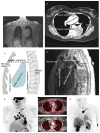Mediastinal paragangliomas: association with mutations in the succinate dehydrogenase genes and aggressive behavior
- PMID: 19075037
- PMCID: PMC4718401
- DOI: 10.1677/ERC-08-0214
Mediastinal paragangliomas: association with mutations in the succinate dehydrogenase genes and aggressive behavior
Abstract
Extra-adrenal pheochromocytomas, otherwise known as paragangliomas (PGLs), account for about 20% of catecholamine-producing tumors. Catecholamine excess and mutations in the genes encoding succinate dehydrogenase subunits (SDHx) are frequently found in patients with PGLs. Only 2% of PGLs are found in the mediastinum, and little is known about genetic alterations in patients with mediastinal PGLs, catecholamine production by these tumors, or their clinical behavior. We hypothesized that most mediastinal PGLs are associated with germ line SDHx mutations, norepinephrine and/or dopamine excess, and aggressive behavior. The objective of this study was to characterize genetic, biochemical, and clinical data in a series of ten patients with mediastinal PGLs. All ten primary mediastinal PGL patients had germ line SDHx mutations, six in SDHB, and four in SDHD genes. Chest or back pain were the most common presenting symptoms (five patients), and catecholamines and/or their metabolites were elevated in seven patients. Additional tumors included head and neck PGLs in four patients, pheochromocytoma in one patient, and bladder PGL in another. Metastatic disease was documented in six patients (60%), and a concurrent abdominal mass was found in one patient. We conclude that mediastinal PGLs are strongly associated with SDHB and SDHD gene mutations, noradrenergic phenotype, and aggressive behavior. The present data suggest that all patients with mediastinal PGLs should be screened for SDHx gene mutations, regardless of age.
Conflict of interest statement
The authors declare no conflict of interest prejudicing the impartiality of the research.
Figures

References
-
- Astuti D, Latif F, Dallol A, Dahia PL, Douglas F, George E, Skoldberg F, Husebye ES, Eng C, Maher ER. Gene mutations in the succinate dehydrogenase subunit SDHB cause susceptibility to familial pheochromocytoma and to familial paraganglioma. American Journal of Human Genetics. 2001;69:49–54. - PMC - PubMed
-
- Baysal BE, Ferrell RE, Willett-Brozick JE, Lawrence EC, Myssiorek D, Bosch A, van der Mey A, Taschner PE, Rubinstein WS, Myers EN, et al. Mutations in SDHD, a mitochondrial complex II gene, in hereditary paraganglioma. Science. 2000;287:848–851. - PubMed
-
- Benn DE, Gimenez-Roqueplo AP, Reilly JR, Bertherat J, Burgess J, Byth K, Croxson M, Dahia PL, Elston M, Gimm O, et al. Clinical presentation and penetrance of pheochromocytoma/paraganglioma syndromes. Journal of Clinical Endocrinology and Metabolism. 2006;91:827–836. - PubMed
-
- Bouhouch A, Hendriks JM, Lauwers PR, De Raeve HR, Van Schil PE. Asymptomatic pheochromocytoma in the posterior mediastinum. Acta Chirurgica Belgica. 2007;107:465–467. - PubMed
-
- Brown ML, Zayas GE, Abel MD, Young WF, Jr, Schaff HV. Mediastinal paragangliomas: the Mayo Clinic experience. Annals of Thoracic Surgery. 2008;86:946–951. - PubMed
Publication types
MeSH terms
Substances
Grants and funding
LinkOut - more resources
Full Text Sources
Medical
Miscellaneous

